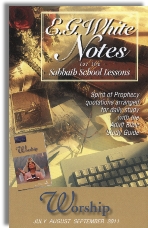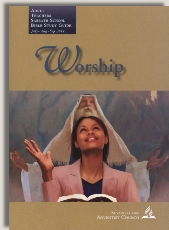|
||||||||||||||
Commentary on "Worship in Genesis: Two Classes of Worshipers"
Day 1: Sabbath Afternoon, June 25, 2011 - Introduction
Overview
This week, the focus is primarily centered in the book of Genesis with the theme that there are two types of worshipers typified by the actions of Cain and Abel related in Gen. 4:1-24. The one worships the true Creator and the other worships the beast and his image.
The memory text for the week is:
When Jacob awoke from his sleep, he said, “Amen, the Lord is in this place and I did not know it.” He felt awe and said, “How awesome a place! This is no other than God’s house; this is the gate of heaven.” (Gen 28:16-17 MLB)
Observations
Today’s lesson beings with several assumptions that really should have been preceded with a biblical foundation. The following passage, referred to later this week, is offered now as an illustration of what true worship is:
FOLLOWING THIS, God tested Abraham. He said to him: Abraham! He answered, “Here I am.” Take now your son, He said, your only one, Isaac, whom you love; betake yourself to the region of Moriah and there offer him up as a burnt-sacrifice on one of the summits which I will designate to you. Early next morning Abraham got up, saddled his donkey, selected two young men to go with him, as well as his son Isaac, split the wood for a burnt-offering, then started out for the location of which God had told him. On the third day Abraham looked up and in the distance saw the place. Abraham said to his young men, “Stay here by yourselves with the donkey; while I and the lad go yonder; so we may worship and return to you.” Abraham took the wood for the burnt-offering and laid it on Isaac, his son, while he carried in his hand the torch and a knife; so the two walked together. “My father,” Isaac said to his father Abraham, who said, “Here I am, my son.” Then he inquired, “Here are the fire and the wood; but where is the lamb for the burnt-offering?” Abraham answered, “My son, God will provide Himself the lamb for the burnt-offering”; so the two walked on together. When they reached the spot of which God had told him, Abraham built the altar there; then he arranged the wood and bound his son Isaac, whom he laid on the altar upon the wood. Abraham then reached out his hand and took hold of the knife to slay his son; but the Angel of the Lord called out to him from heaven, Abraham! Abraham! He said, “Here I am.” Do not lay hands on the lad, He said, do nothing to him; for now I know that you revere God. You have not held back from Me your son, your only one. (Gen 22:1-12 MLB)
Specifically, a lesson on worship should have begun by first defining what Biblical worship is. Using the text just quoted as our guideline and Abraham as our role model we see that true worship is when we ‘revere God’ by our words and actions of reverence and submission. Notice that Abraham said “Here am I” when God first spoke to him. He had a ‘hearing ear’ and he didn’t waste time questioning what God clearly told him to do. Early the next day he was on his way. He understood ‘his marching orders’ and responded accordingly.
When God accepts Abel’s offering but rejects Cain’s, God does not state his reason. We soon learn that true worshipers willingly submit to and revere their Creator. When rebuked by God, Cain’s response of directing his anger towards his brother reveals his rebellion towards his Creator. Cain displays all the attributes that are the very opposite of worship.
It is assumed in the lesson that Abel’s offering was based on “salvation by faith” and Cain’s was “based on works”. However, the lesson author has failed to support this understanding with biblical references. The fact is, we are not told what motivated each of the brothers to bring their offering before the Lord or even if they had any understanding of what their offering was meant to be, a sacrifice acceptable to the Lord. True worshipers of God do not have to understand what their Creator has in mind. The difference between the brothers is that one was in submission and one was not. Knowing God is sovereign means we trust and obey even when we do not understand. That central and immediate lesson is nothing more complicated that to simply to put our total trust in God. The fuller and deeper understanding of the blood sacrifice required by God comes later, as each of us grows in our spiritual maturity.
For the life of a creature is in the blood, and I have appointed it to you to make atonement on the altar for your lives, since it is the lifeblood that makes atonement. (Lev 17:11 HCSB)
For if the blood of goats and bulls and the ashes of a young cow, sprinkling those who are defiled, sanctify for the purification of the flesh, how much more will the blood of the Messiah, who through the eternal Spirit offered Himself without blemish to God, cleanse our consciences from dead works to serve the living God? (Heb 9:13-14 HCSB)
We cannot assume, without having a biblical foundation, that Cain or Abel understood the need for the shedding of the blood of an innocent sacrifice to make atonement for their sins. In the case of what we learn about Abraham, it is natural for us to ponder a bit and wonder if he knew how prophetically he was speaking when he said “My son, God will provide Himself the lamb for the burnt-offering”.
Summary
- Any biblical topic that is presented in the form of instruction should begin with a firm biblical foundation rather than unsupported assumptions such as was done in this lesson.
- While the offerings brought by Cain and Abel do have far reaching meaning, we are left with many more questions than answers if we do not move beyond the account found in Genesis chapter four. However, when in a similar situation where we understand what God is saying our immediate reaction should be modeled after Abraham’s example and obey.
- The immediate lesson in the account of Cain and Abel is to simply to trust and obey God. Even in our case, understanding the need and meaning of the blood sacrifice may come much later as we each grow in our spiritual maturity.
- When we examine the life of Abraham, we learn what true worship of God our Creator is. What more can be said of a person than; ‘I know that you revere God’?
Copyright 2011 BibleStudiesForAdventists.com. All rights reserved. Revised June 26, 2011. This website is published by Life Assurance Ministries, Glendale, Arizona, USA, the publisher of Proclamation! Magazine. Contact email: BibleStudiesForAdventists@gmail.com.
The Sabbath School Bible Study Guide and the corresponding E.G. White Notes are published by Pacific Press Publishing Association, which is owned and operated by the Seventh-day Adventist church. The current quarter's editions are pictured above.
Official Adventist Resources
Standard Edition Study Guide Week 1
Teacher's Edition Study Guide Week 1
Easy Reading Edition Study Guide Wk 1
Search the Complete Published Ellen G. White Writings
Please Support This Project


